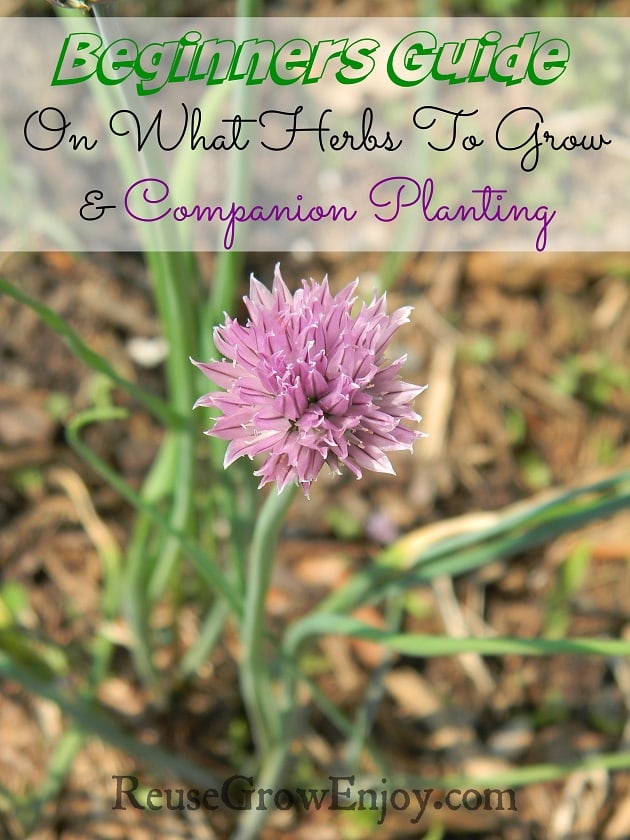Wanting to start a herb garden and wondering what herbs to grow? Some are easier to grow than others and I will go over a few of the best. I will also talk about some of the best companion planting options.

Beginners Guide On What Herbs To Grow
And Companion Planting
If you’re new to growing herbs or in a hurry to taste the fruits of your labor the best way to start off is by purchasing a plant or better yet get one from a friend. You can plant from seeds but will take longer for your return.
In this beginner’s guide on what herbs to grow, you will find herbs that are easy to grow and they are perennials as well, meaning they will come back each year. We will also include a few annuals.
Plus we have included companion planting for each herb. That will help you to know what other plants do well alongside them.
Top 3 Easiest To Grow:
Chives:
Are members of the lily family, not only are they delicious; they have beautiful purple flowers! For fast growth, plant in full sun, and in rich well-drained soil.
Companion Planting: Carrots
Mint:
All mint is easy to grow, maybe a little too easy. Mint grows quickly and is very invasive, so plant it where you want it to be.
Mint comes in many different types from the well-known peppermint and spearmint to the less known chocolate and apple mints.
Plant mint in a cool, moist spot they like partial shade but will grow in full sun.
Companion Planting: Cabbage and tomatoes.
Basil:
Basil is one that grows really well indoors or outside. It likes moist but not wet soil and needs full sun. This one is an annual plant meaning it will only grow for the season and will not come back.
You can even regrow a basil plant by cutting a piece off a healthy basil plant. See how in this post on How To Propagate Basil (aka Grow Basil From Cuttings).
Companion Planting: Tomatoes, asparagus, peppers, oregano.
Others That Are A Little Harder But Still Easy:
Oregano:
Oregano loves loamy soil and full sun. While oregano starts out as a ground hugger, it can quickly grow to be 2 ft. tall.
There are several types of oregano but personally, I prefer the Greek variety.
Companion Planting: Gets along well with all vegetables.
Rosemary:
Rosemary loves well-drained soil and full sun. It grows slowly and first but normally takes off in its second year and can grow to be 3 ft. tall. In warmer climates, it makes a beautiful evergreen hedge.
Prune back the dead woody parts from the plants in the early spring.
Companion Planting: beans, cabbage, carrots, and sage
Sage:
Like rosemary, sage loves well-drained soil and full sun. Sage, however, does not tolerate summer heat and humidity well and may die off in hotter climates.
In early spring prune plants back cutting away the oldest growth to promote new growth.
Companion Planting: Rosemary, cabbage, and carrots; but keep it away from cucumbers.
Thyme:
While there are many types of thyme, English thyme is most often used for cooking, my personal favorite, however, is lemon.
Thyme is a low-growing herb and makes a beautiful grown cover.
Companion Planting: Cabbage.
Did you find this Beginners Guide On What Herbs To Grow And Companion Planting helpful? If so you may also want to check out our post on Plants That You Can Plant One Time And Eat From Forever.


Amanda C. says
Lovely post! My sister just started a small garden and she wants to grow some herbs in it. I’m sure your post will be of a great help for her, so I’m definitely recommending it . Thanks for the nice information and happy gardening!
Reuse Grow Enjoy says
So happy you found it helpful! I am sure your sister will find that she loves gardening. It is one of those things that after you start, you are hooked for life! Happy gardening!
Anonymous says
Thank you for all the information
Reuse Grow Enjoy says
You are very welcome!